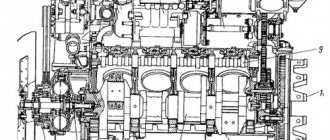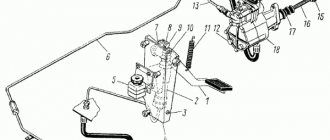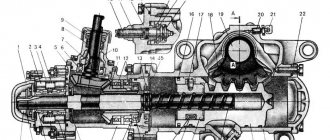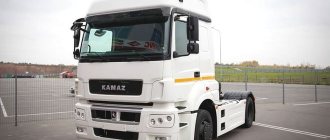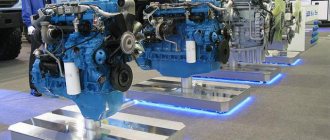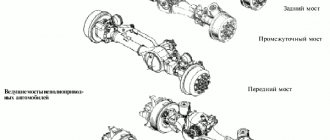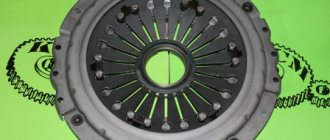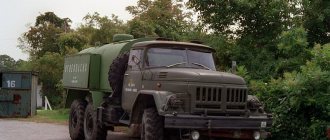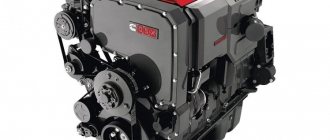KamAZ-5320 is one of the first representatives in the line of trucks from the Kama plant. A massive onboard tractor is used to work with towed components GKB-8385. Its purpose is to carry out transportation processes in the construction industry and in almost all areas of industrial and economic activity.
The production of KamAZ-5320 started in 1968. For a long time, the Kama Automobile Plant did not dare to restyling the model. Minor cosmetic changes to the truck occurred only in 2000.
When considering the technical parameters of the vehicle, it becomes clear that the KamAZ-5320 is excellent for long- and short-distance transportation of goods. The tractor feels equally confident on city roads and on intercity highways. The car is adapted to Russian conditions and starts easily even in severe frosts.
The model was exported to 40 countries around the world, earning popularity not only in the domestic market, although it was originally created specifically for domestic consumers.
KamAZ-5320 is an onboard cargo tractor, which is often used as a road train for transporting various cargoes. The car is also known for the fact that many models for transporting medium-tonnage cargo were built on its basis.
Among them:
- base flatbed model 4325;
- truck 53212;
- truck tractor 5401;
- extended tractor 5325;
- dump truck 551.
Specifications
The overall dimensions of KamAZ-5320 (length - 7435 mm, height - 3350 mm, width - 2500 mm) allow you to transport quite massive loads. The tractor can be operated with a load of 8000 kg (45% on the front axle, 55% on the rear axle) and an additional trailer of 8000 kg. The wheelbase of the car is 3190 mm, and the minimum turning radius is 9300 mm.
The mass of the tractor itself is 7080 kg. The maximum load and trailer increase this figure to 26,500 kg. The vehicle's climbing angle is 30%.
The truck's run-out from 50 km/h is 700 m, and the braking distance at a speed of 60 km/h is 36.7 m. The maximum vehicle speed is 80 km/h.
Engine
The KamAZ-5320 engine is a 4-stroke diesel unit of the KamAZ-740.10 model with an 8-cylinder design. The engine has a V-shaped cylinder arrangement and closed-type nozzles. The power plant includes an all-mode speed controller, a dry air filter with a clogging indicator and a replaceable filter element, a fuel injection advance clutch and an electric flare device (EFD). Optionally, the unit is equipped with a pre-start heater PZD-30.
Motor characteristics:
- working volume – 10.85 l;
- rated power – 154 (210) kW (hp);
- maximum torque – 637 Nm;
- rotation speed – 2600 rpm.
- cylinder diameter – 120 mm.
Fuel consumption
Thanks to several upgrades, fuel consumption in the KamAZ-5320 was significantly reduced. This allowed the domestic model to compete on equal terms with foreign analogues. It was the economical processing of fuel that made the truck so popular in the domestic market. For 100 km of travel, the average fuel consumption is about 34 liters.
The tractor is equipped with two types of fuel tanks: 250 and 175 liters. This allows the car to cover significant distances without refueling.
Transmission
It represents the presence of a multi-stage system, which consists of a 2-stage divider and a 5-speed gearbox. This system makes it possible to obtain, in addition to standard gear regulators, auxiliary forward and reverse gears. Don't forget about installing the synchronizer.
The KamAZ 5320 gearbox has a 2-disc clutch, which does not lose its popularity. This device operates as a friction clutch, and can be activated using a hydraulic-pneumatic booster. It is controlled using peripheral springs.
The truck's run-out from a speed limit of 50 km/h is 700 meters, and the braking distance from a speed of 60 km/h is 36.7 meters. It is recommended to carry out maintenance of the KamAZ 5320 vehicle after every 100-kilometer run.
Maintenance service after 8,000 kilometers. Machine maintenance includes diagnostics of mechanical and electrical services, fastening work and lubrication of mechanical connections.
Suspension
The suspension located in front has springs (semi-elliptical, where there are sliding rear ends). The springs operate together with dual-type hydrotelescoping shock absorbers.
The rear-mounted suspension is a balancer type. There are also semi-elliptic leaf springs, sliding front and rear ends. Spring leaves have a T-shaped section.
Steering
Such a truck is controlled using a hydraulic booster, which is combined with a steering device.
Brake system
In order to regulate the speed of the KamAZ-5320 and stop it effectively, a specialized device is used. Each of the 6 wheels of the truck has brake devices installed, which operate using a pneumatic drive mechanism. The dual-circuit device allows the driver to switch the rear axle into a capable position, while the trolley mounted at the rear starts separately.
Together with the brake of the parking sample, a spare brake was also combined, which is a motor retarder with a pneumatic drive. The trailer was equipped with a combined brake function. The brake system is presented in the form of drums. Steering is provided using a mechanism that consists of a screw with a nut and a rack-and-pinion piston.
Specifications
| Weight parameters and loads | |
| Vehicle curb weight, kg. | 6220 |
| Front axle load, kg. | 3210 |
| Car load capacity, kg. | 8860 |
| Total weight, kg. | 15305 |
| Front axle load, kg. | 4375 |
| Load on the rear trolley, kg. | 10930 |
| Engine | |
| Model | 740.11-240 |
| Type | diesel turbocharged |
| Rated power, gross, kW (hp) | 176 (240) |
| — at crankshaft rotation speed, rpm | 2200 |
| Maximum torque, Nm (kgcm) | 834 (85) |
| — at crankshaft rotation speed, rpm | 1200-1400 |
| Location and number of cylinders | V-shaped, 8 |
| Working volume, l. | 10,85 |
| Cylinder diameter and piston stroke, mm | 120/120 |
| Compression ratio | 16 |
| Supply system | |
| Fuel tank capacity, l. | 250 |
| Electrical equipment | |
| Voltage, V | 24 |
| Batteries, V/A hour | 2x12/190 |
| Generator, V/W | 28/1000 |
| Clutch | |
| Type | friction, dry, double-disc |
| Drive unit | hydraulic with pneumatic booster |
| Diameter of pads, mm. | 350 |
| Transmission | |
| Type | mechanical, ten-speed |
| Control | mechanical, remote |
| Transfer case | |
| Type | mechanical, 2-speed with lockable center differential |
| Control | pneumatic |
| Brakes | |
| Drive unit | pneumatic |
| Dimensions: | |
| Drum diameter, mm | 400 |
| Brake lining width, mm | 140 |
| Total area of brake linings, sq.cm | 6300 |
| Wheels and tires | |
| Wheel type | diskless |
| Tire type | pneumatic, chamber |
| Tire size | 9.00R20 (260R508) |
| Cabin | |
| Type | front, located above the engine, 3-seater |
| Execution | without a bed |
| Characteristics of a vehicle with a gross weight of 15305 kg | |
| Maximum speed, km/h | 90 |
| Maximum slope angle overcome by the vehicle at full weight, % | 30 |
| External overall turning radius of the vehicle, m | 9,3 |
| Optional equipment | |
| Engine preheater, seat belts, fog lights. | |
Marking
The engine marking number is 8 digits, which are applied to the untreated surface of the engine cylinder block and include the base model code (engine number) and modification code (740.51-320). Catalog markings in the documentation include additional numbers that give an idea of the configuration, type and model of the fuel pump, and applicability.
Examples of markings and their interpretation:
- 740.31-1000400-41 – set with injection pump Bosch 0402 648 608 for KAMAZ-53215 and 43253;
- 740.30-1000402-80 – motor with pump YAZDA 337-1111005-20 (with boost corrector and injector 273-20) for KAMAZ-43118 and so on.
Device
Each of the 6 wheels of KamAZ-5320 is equipped with brake devices that provide effective braking. The brake system itself operates from a pneumatic drive device having a 2-circuit design. It is capable of bringing the rear bogie and the front axle of the vehicle into working position independently of each other. The driver controls the drive via a foot lever mechanically connected to the brake valve.
Appearance
So, what is the KamAZ-5320 if you look at it externally? This is a tractor that can work in conjunction with a GKB trailer. The carrying capacity is more than decent - 8 tons, but in a towed trailer you can grab another “eight”. The KamAZ 5320 body is a metal platform, where the side sides and the rear can be opened.
Thanks to this, it is possible to provide more comfortable loading and unloading of any cargo on each of the three sides. The floor was made using durable wood. If necessary, you can install a protective awning.
The very appearance of the car from the Kama plant is quite recognizable, because even today you can often see them on various roads. Although, it is worth admitting that the cabin, frankly speaking, is outdated and needs new modernization or, even better, a completely new design.
The curb weight of the 5320 model is just over 7 tons, the trailer weighs 3.5 tons. If the road train is fully loaded, its total weight can reach 26.5 tons. Now let's go over the dimensions.
The length of the KamAZ-5320 stretches 7.43 meters, and the width - 2.5 meters. The height of the truck is 3350 mm, but the wheelbase is 3190 plus 1320 mm.
Cabin interior
The Soviet-made truck cabin was designed for three seats. At the same time, there was no separate space for “sleeping”. Despite this, the KamAZ interior has long been considered the standard of road comfort among trucks of that time.
What other truck could boast of excellent noise and thermal insulation, places for attaching seat belts, and a driver's seat that is adjustable to the weight of the driver. Moreover, the driver's seat was of the sprung type.
Of course, there are some drawbacks: the steering wheel is too large and the gearbox is somewhat inconveniently placed. However, you get used to everything, so you could always turn a blind eye to these shortcomings of KamAZ. The cabin interior has all the necessary instrumentation and indicators that allow the driver to read information about the condition of the car.
The dashboard has a signal system with excellent visibility of dials and switches. When compared with other similar trucks, the 5320 took a confident first place in ensuring the safety of the driver and the passengers sitting next to him.
The 5320 model is also different in that it has a two-pointer pressure gauge, a switch that adjusts the position of the platform, and an electronic speed sensor of the power unit.
But there are still a lot of shortcomings in the interior of the Kama car. The salon looks in a spartan style. The front (windshield) glass is divided into two parts. The pedals are not the most comfortable, which can make you tired on long trips. However, at the time when KamAZ trucks were just being produced, the interior was one of the best and most comfortable.
Frame
The KamAZ-5320 frame is a load-bearing spar type with riveted joints. It consists of two parallel beams-spars connected to each other by seven transverse beams.
Carbon steel is used as the material for manufacturing the structural components.
The front parts of the load-bearing side members have a beveled structure for mounting the suspension. Towing hooks are also attached to them. The front buffer is mounted to the supporting beams using bolts.
Service
Change of oil.
It is recommended to change the oil every 10,000 km, regardless of the frequency indicated in the instructions (this is due to the high sulfur content in Russian diesel fuel, which leads to rapid oxidation of the oil). During long-term operation at low speeds - it is recommended not lower than 1000 rpm - at parking lots, overnight stays, it is recommended to change the oil after 7500 km.
For turbodiesels, starting from Euro-2, it is possible to carry out maintenance at intervals of 20,000 km.
Replacing the air filter.
During daily inspection, inspect the filter elements and replace as necessary.
In difficult conditions, carry out daily cleaning of surfaces from dust and dirt, change filter elements every 3-4 thousand kilometers. If the air filter fails, a lack of air supply to the cylinders leads to incomplete combustion of fuel, which leads to engine failure. Start driving only with a warm engine.
Driving without warming up will lead to replacement of liners and piston rings.
Experts recommend checking the fuel system and adjusting the valves at every service. This will reduce wear on the power unit and can extend its life by another 100 thousand km.
Use of KamAZ in army units
From the moment they entered production, KamAZ trucks also entered the formations of the USSR Armed Forces.
These vehicles received their baptism of fire at OKSVA during combat operations in Afghanistan, where they gained the reputation of being reliable and powerful vehicles, including when used in the highlands.
The main differences between the army modification of KamAZ and the civilian line were: reinforced design, a reshaped bumper, and the mandatory presence of a tire pressure regulation system. There were other differences, not so significant. The scope of use of machines in the army was quite wide:
- a vehicle for transporting bulk cargo and personnel;
- use as a platform for installing various radio equipment: command and control vehicles, launch control command posts and mobile stations for performing other tasks;
- armored vehicles for transporting personnel in the theater of military operations, this type of vehicle was not mass-produced, the armor was attached to the base model;
- vehicles for escorting convoys, gun trucks with ZU-23-3 weapons.
It’s worth talking about “gun trucks” in a little more detail; these vehicles initially had as their task the escort of convoys as they were escorted through the mountains of Afghanistan. A ZPU-4 or ZU-23-2 anti-aircraft gun was installed in the back of the vehicle.
These installations had the ability to fire all around, had an anti-aircraft elevation angle and powerful cartridges; their shells and bullets could reach the enemy at long range and altitude. This made it possible to effectively combat ambushes on the road.
The armoring of such vehicles was often makeshift and consisted of hanging the cabin doors with bulletproof vests, less often they were sheathed with metal.
The charger installation itself was covered with doors from the infantry fighting vehicle or other improvised means, the purpose of which was to protect the installation crew, although it was minimal. Subsequently, the production of such support products was suspended.
The armored Urals and KamAZs, which appeared during the Caucasian Wars and were nicknamed “Pokemons,” are also a product of handicraft production; there are practically no such vehicles in the series. Although their high efficiency in operation has been proven.
Malfunctions
If the engine does not start, see the table below:
| Cause of malfunction | Remedy |
| No fuel in tank | Fill the fuel tank and be sure to bleed the fuel system. |
| Presence of air in the fuel supply system | Fix the leak and then bleed the system. |
| Failure to adjust the fuel injection advance angle | Adjust the lead angle. |
| Freezing of water that gets into the fuel pipes or onto the fuel tank intake screen | Warm fuel filters, tanks and pipes carefully with a rag soaked in steam or hot water; do not use open fire for heating. |
Advantages and disadvantages
Pros of the car
- Suitable for any climate - from +50 to -40 degrees;
- Excellent for Russian roads;
- Good maintainability;
- Relatively low price for spare parts;
- Truck cost;
- Easily tolerates overloads;
- Gearbox with divider;
- May make it to the garage with some damage.
- Acceptable ride height;
- Practicality;
- Excellent visibility of the vehicle;
- Good braking system;
- There are various modifications that expand the capabilities of the truck.
Transmission
The clutch on this engine is a double-disc, dry diaphragm type, hydraulically driven and pneumatically assisted. The diameter of the pads is 350 mm. The gearbox is mechanical, ten-speed, with a front divider. The basis of this gearbox is a five-speed gearbox, plus a divider and a range multiplier. The forward speeds are connected using synchronizers, and the rear speeds are connected through a gear coupling. The gear ratios are set as follows: 1 – 7.82; 2 – 4.03; 3 – 2.5; 4 – 1.53; 5 – 1.0; Zx – 7.38.
The transfer case is two-stage (with gear ratios 1.692:1 and 0.917:1), with a pneumatic drive and a locking center differential. The main gear is double, which includes a pair of bevel and a pair of spur gears (6.53:1). The front axle drive is permanent and cannot be switched off.
Video
Please note that KamAZ-5490 is the successor to the 5460 model and, in fact, is the flagship model of the Russian brand.
It is not surprising that a car of this level has received many additional options designed to make the car even better in all respects. For example, among them we can note the air suspension of the seats, a full-fledged climate system and adaptive cruise control.
Today, 5490 is widely in demand in 80 countries around the world. First of all, these are Russia and the Baltic countries. Despite the advanced design, the car is inexpensive and easy to operate, and has high reliability of all components and assemblies. Model 5490 meets all European standards.
The main purpose of the KamAZ-5490 is to transport various materials, including food and construction materials. The car can handle long distances without any problems, as it has the potential of a long-haul tractor. The car is widely in demand among private carriers and organizations.
General information
The presentation of KamAZ-5490 took place in 2011. Without a doubt, this model can be considered the most technically advanced of all KamAZ vehicles presented today. It is noteworthy that local production allows the KamAZ-5490 to be produced with 60% Russian components, which is an important advantage. Thanks to this, the truck is both high-tech and relatively affordable, even compared to foreign analogues. It is commendable that during the premiere, the Kama Automobile Plant had already received four lucrative contracts from customers who showed keen interest in the 5490. However, despite the premiere show in 2011, serial production of trucks was only mastered in 2013.
KamAZ-5490 is a multi-purpose truck tractor of the main class. The distinctive features of the vehicle are high load capacity, increased comfort, as well as a German-made cabin and engine. The truck is certainly a technological breakthrough in the history of the Kama enterprise, which, in fact, until that time had only produced modified versions of trucks from the USSR era. KamAZ-5490 embodies the latest Russian and German developments. It is worth noting the fact that a new technological process is used to produce this model. To do this, the Kama company had to seriously upgrade its facilities.
About the racing KamAZ-4326 VK - a multiple winner of the Dakar and Silk Way rallies
KamAZ-4326 VK is a racing truck weighing eight and a half tons, which can travel off-road at a speed of 140 km/h. It was equipped with an eight-cylinder M-shaped 16.2-liter YaMZ 7E846.10-07 engine with a power of 830 horsepower. The average diesel fuel consumption on asphalt is about 50-60 liters per 100 km, on off-road - 130-150 liters, and on sandy desert rough terrain - about two hundred liters. The fuel tank holds a ton of diesel fuel. Gearbox – 16-speed, from ZF.
Behind the bright body, colored with sponsors' logos, there is emptiness. Lightweight aluminum panels only imitate the cargo compartment. All the equipment necessary for the crew is transported in a box, which is located in the area of the rear axle - a set of tools and spare parts, equipment for digging the truck out of the sand, a fire extinguisher. Two spare tires are located in the rear of the "cargo compartment".
The KamAZ-4326 VK truck has drum brakes, since after attempts to use disc mechanisms it was decided to abandon them - they burn after intense braking in mountainous areas. But competitors have disc brakes, so the KamAZ-Master team does not exclude their use and is looking for special materials that can make the brakes more durable.
